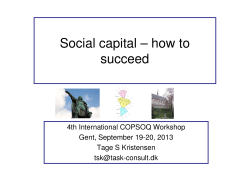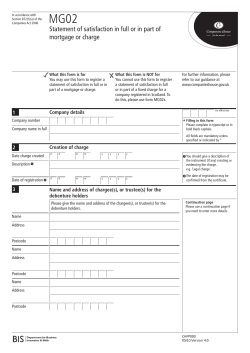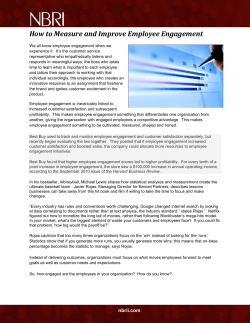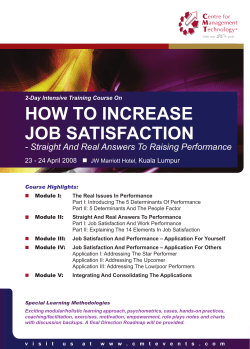
How to Build Successful Customer Satisfaction and Loyalty Programs That Drive Growth
SPECIAL REPORT How to Build Successful Customer Satisfaction and Loyalty Programs That Drive Growth By Julie Schwartz Companies struggle to get a clear view of customer satisfaction and loyalty because these programs are usually managed separately. By integrating them, not only can companies accurately judge customer opinion, but they will also be better able to act on those opinions and build a cadre of loyal customers and advocates. Abbreviated Summary | October 2012 Note: ThisAbbreviated summary highlights some of the significant findings from How to Build Successful Customer Satisfaction and Loyalty Programs That Drive Growth.A more in-depth analysis can be found in the full report. Take a HolisticApproach to Managing the Customer Experience Every B2B company can point to some big successes A holistic approach to a customer loyalty and in building strong after-sales relationships with satisfaction program requires: customers. But not enough companies take a broad • view of the customer relationship and create an integrated approach that begins the moment a customer first engages with the company and extends post-sale to the point when that customer becomes a faithful advocate and perhaps even a partner in co-developing new solutions. • A well-defined organization structure • Chief Customer Officer • Customer Experience Center of Expertise A rigorous process and program design Listening Acting Evaluating ©2012, ITSMA | How to Build Successful Customer Satisfaction and Loyalty Programs That Drive Growth Organizational Structure: Bring Programs Together In most companies, customer satisfaction and loyalty programs are not managed at a high-enough level, which leads to the silo problem because those who manage them have neither the seniority nor the leadership skills to work across programs. ITSMA research finds that companies invest a lot in service delivery but don’t pay enough attention to other pieces of customer service. These uncoordinated touch points result in an inconsistent customer experience and fragmented customer satisfaction and loyalty efforts that never rise to a strategic level. Here’s how you bring your programs together: 1. Appoint a Chief Customer Officer. Companies will never be able to manage every touch point of the customer experience holistically unless a senior-level executive is in charge of the end-to-end customer experience. 2. Create a center of expertise to bring all the different programs together. Centralization will enable process and experience sharing to improve existing programs, as well as ensure the effectiveness of new ones. ©2012, ITSMA | How to Build Successful Customer Satisfaction and Loyalty Programs That Drive Growth Organizational Structure: Centralize Oversight When measuring customer satisfaction and loyalty, it’s When you end up with little fiefdoms all doing things easy to game the system. Another important role of the autonomously, employees are not being held to the center of expertise is to act as referee over the same standard across the company. And that means programs, ensuring that all areas of the company it’s impossible to establish a meaningful benchmark play by the same rules when it comes to the high- for improvement. If measurement—and stakes issues of loyalty and satisfaction. interpretation of the results—is not consistent, companies lose the programs’ value. ©2012, ITSMA | How to Build Successful Customer Satisfaction and Loyalty Programs That Drive Growth Listening: Gather Data and ChooseApproach The tendency in many companies is to equate the customer satisfaction survey with the overall program; Things to keep in mind: however, the survey is just part of the customer 1. Customer information integrity. satisfaction and loyalty program. Further, the survey Without data integrity, companies cannot measure should not be the sole customer listening post. satisfaction or loyalty consistently or effectively. 2. Choose the best approach for your business. You can conduct surveys on a project or transactional basis, a relationship basis, or both, depending on what makes the most sense for your business model. ©2012, ITSMA | How to Build Successful Customer Satisfaction and Loyalty Programs That Drive Growth Listening: Gather Feedback What exactly should companies be measuring when they ask With the increasing proliferation of channels, customers to participate in satisfaction and loyalty programs? surveys are not enough. Other customer listening ITSMA recommends that companies create a customer loyalty posts include: index that incorporates three broad measures: • Customer service hotline 1 2 3 Satisfaction Loyalty Advocacy • Customer visits • Online communities • Social media • Customer councils/advisory boards • Face-to-face individual customer interviews • Customer reviews Note: The Net Promoter Score is based on the model described in Fred Reichheld’s book, The Ultimate Question (2007). Average B2B NPS = 24; best-in-class NPS > 50. http://www.netpromoter.com/netpromoter_community/blogs/conference_sf_2009/2009/01/27/b2b -and-nps-a-match-made-in-heaven ©2012, ITSMA | How to Build Successful Customer Satisfaction and Loyalty Programs That Drive Growth Acting: TakeAction with All Customers How a company responds to Integrating Customer Satisfaction and Loyalty Programs Creates a customer feedback says a lot Continuous Feedback Loop of Information and Action about the importance it places on customer relationships. Companies that promptly take Client Feedback Strategic/Operational Changes Services Provider Action • Advocacy Program Promoters End of Project Customer Engagement Activities action in response to both • Account Based Marketing • Client Councils/Advisory Boards positive and negative feedback have made a Transactional commitment to improve the customer experience. However, responding customer by customer • Reference Program Annual • Conduct surveys • Monitor all customerlistening posts • Capture clientinitiated feedback • Thought Leadership Activities • Special Events/Briefings Passives • Collaborative Development/Beta Projects • Recreation and Social Activities • Online Communities • Key Executive Relationship Program is not enough. Some feedback Detractors needs to be addressed on a more strategic, company-wide level. Remediation Actions Ongoing ©2012, ITSMA | How to Build Successful Customer Satisfaction and Loyalty Programs That Drive Growth Acting: Take a Programmatic Approach to Customer Engagement Customer engagement, which strengthens ITSMA has created a framework, consisting of relationships and builds loyalty with key stakeholders 6 elements, to help companies create more at existing customer accounts, is most successful effective customer engagement programs. when managed programmatically—not as ad hoc, one-off activities. ©2012, ITSMA | How to Build Successful Customer Satisfaction and Loyalty Programs That Drive Growth Evaluating: Measure to Prove and Improve the Program As with any business activity, it is important to Keep these in mind when coming up with and measure results to know what’s working and what measuring evaluation metrics: isn’t, as well as to communicate the value. In other • words, we measure to both prove and improve the results delivered by the program. Using baselines is a powerful way to demonstrate the value of the customer satisfaction and loyalty program. Showing the value of these programs • • overall program • individual activity • specific accounts Measure your listening program, not just customers’ responses helps executives understand their importance, resulting in continued support and funding. Measure results at three levels • Tailor results reporting to the target audience ©2012, ITSMA | How to Build Successful Customer Satisfaction and Loyalty Programs That Drive Growth Learn More For more information on how to build a best-in-class customer satisfaction and loyalty program, buy the ITSMA Special Report How to Build Successful Customer Satisfaction and Loyalty Programs That Drive Growth.
© Copyright 2025





















